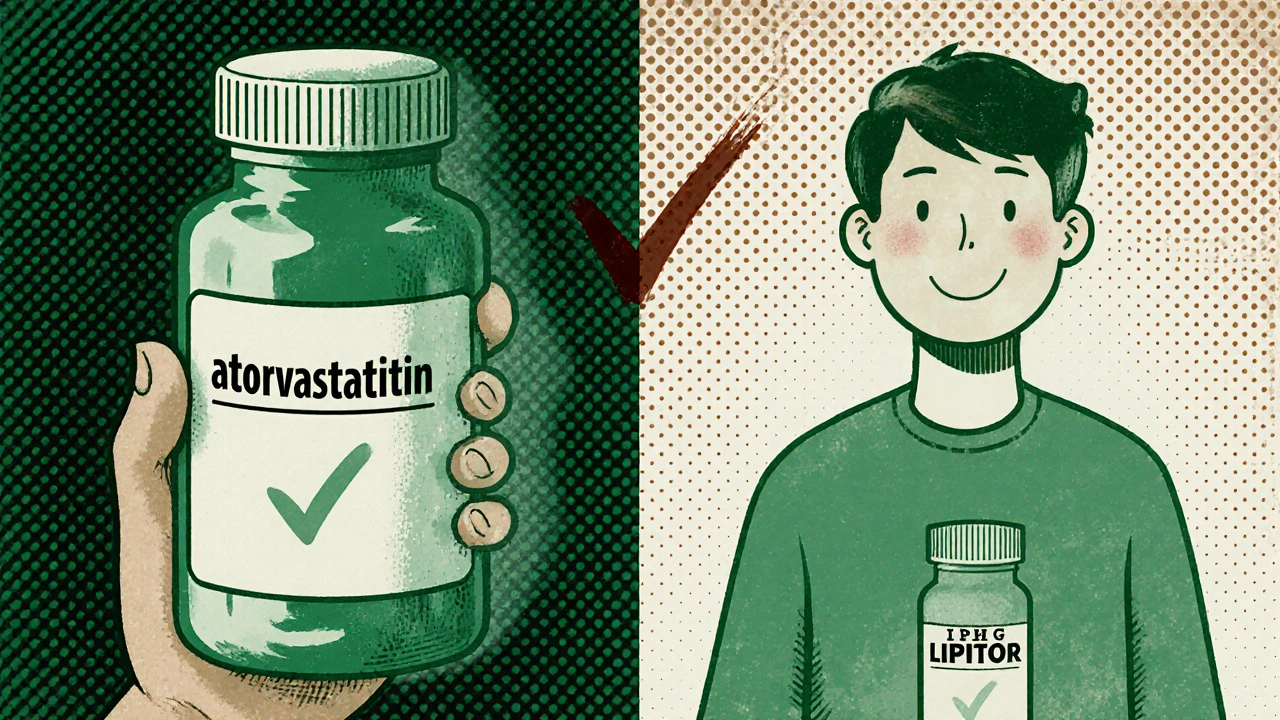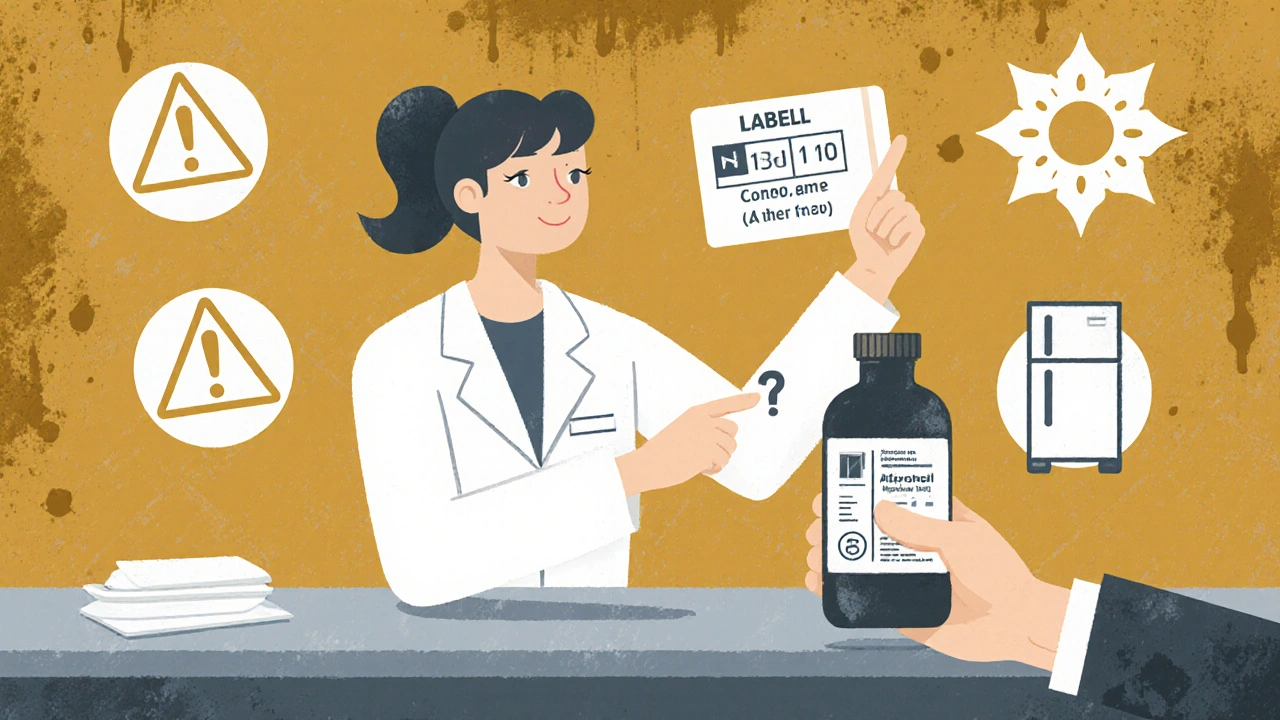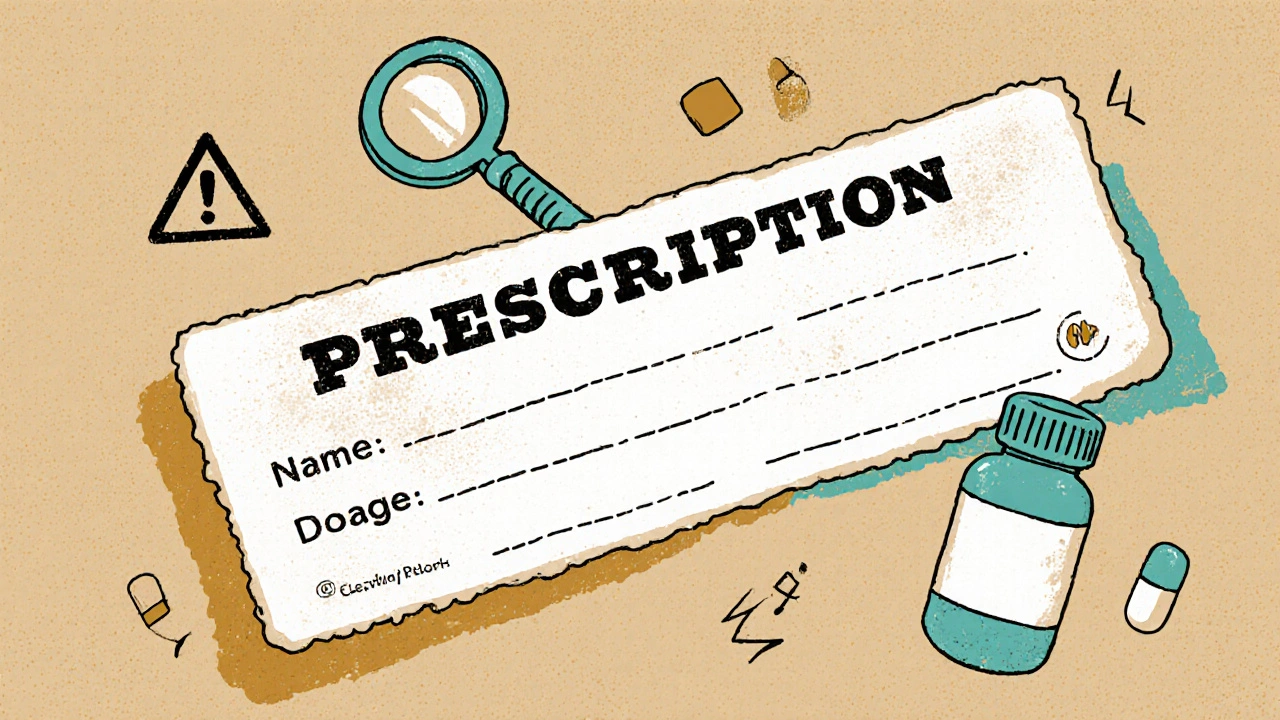Every time you pick up a prescription, you’re handed a small piece of paper that holds your health in its details. But most people glance at it, grab their pills, and walk out - never really understanding what the words, numbers, and symbols actually mean. That’s dangerous. A single misread line can lead to taking the wrong dose, mixing dangerous drugs, or even missing a life-saving instruction. You don’t need to be a pharmacist to read your label. You just need to know what each part is telling you.
Your Name - The First Line of Defense
Your name is printed at the top of every prescription label. It’s not just formality. It’s a safety check. In the U.S., over 1.5 million medication errors happen every year, and many are caused by someone getting another person’s pills. That’s why your name is there. If you see someone else’s name - even a slight misspelling - don’t take it. Walk back to the pharmacy. This simple step stops mix-ups before they start.
Medication Name - Brand vs. Generic
You’ll see two names for your drug: the brand name and the generic name. The brand name is what the drug company calls it - like Abstral or Lipitor. The generic name is the actual medicine inside - like fentanyl or atorvastatin. The generic name is what matters most. It tells you what the drug actually does. Many people think brand names are stronger or better, but they’re not. The FDA requires generics to work exactly the same as brand names. If your doctor switches you from Lipitor to atorvastatin, you’re still getting the same medicine. Always check the generic name, especially if you’re refilling. It helps you avoid paying more for the same thing.
Dosage Strength - How Much Is in Each Pill?
This tells you how much active medicine is in each tablet, capsule, or milliliter of liquid. For example: "50 mg" means each pill has 50 milligrams of the drug. If your label says "100 mcg," that’s 100 micrograms - a much smaller amount. Confusing mg with mcg has led to deadly overdoses. Always double-check the units. If you’re unsure, ask the pharmacist to spell it out. Don’t assume. If you’re taking more than one pill a day, make sure you know how many you’re supposed to take - and when.
Instructions - When, How, and How Often
This section tells you exactly how to take the medicine. It might say "Take one tablet by mouth every 12 hours" or "Take with food." These instructions are not suggestions. They’re based on how your body absorbs the drug. Taking a pill on an empty stomach might make it work too fast. Taking it with grapefruit juice could make it dangerously strong. Some meds need to be taken at the same time every day. Others need to be spaced out. If the label says "as needed," that means only when you feel the symptom - not every hour. If you’re confused, ask: "Should I take this before, during, or after eating?" And never crush or split pills unless the label says it’s safe.
Expiration Date - Don’t Use Old Pills
The expiration date isn’t just a suggestion. After that date, the medicine might not work as well - or worse, it could break down into something harmful. Most prescriptions expire 12 to 18 months after they’re filled. Some, like insulin or eye drops, expire much sooner. If your pill looks different - discolored, cracked, or smells weird - toss it, even if it’s before the date. Never keep old meds for "just in case." They can lose potency or become unsafe. The FDA says expired antibiotics, for example, can fail to treat infections, leading to worse illness.

Prescription Number - Your Pharmacy’s Tracking Code
This number, often labeled "Rx #," is how the pharmacy keeps track of your order. It’s not your medical ID - it’s their inventory code. But it’s still important. When you call for a refill, they need this number to pull up your record. If you switch pharmacies, you’ll need to give them this number so they can transfer your prescription. If you get a new bottle and the Rx number is different, that’s normal - it just means it’s a new fill. But if the name, drug, or dosage doesn’t match what you expect, stop. Call the pharmacy. That number helps them catch mistakes before you take the pills.
Pharmacy and Prescriber Info - Who to Call
Your label should show the pharmacy’s name, address, and phone number. It should also list your doctor’s name. These aren’t just details - they’re lifelines. If you have side effects, if the pill looks wrong, or if you’re not sure how to take it, call the pharmacy first. Pharmacists are trained to answer these questions. If you think your doctor made a mistake - like prescribing the wrong drug - call their office. Don’t guess. Don’t ignore it. One call can prevent a hospital visit.
Visual Description - What the Pill Looks Like
Many labels describe the pill’s shape, color, and imprint. For example: "White, round, film-coated tablet, imprinted with 'A 10'." This helps you recognize your medicine if you have to switch bottles or if you’re traveling. It’s also a safety feature. If your pill suddenly looks different - say, from white to blue - it might be a different drug. That’s happened before. If the pill doesn’t match the description, don’t take it. Take it back to the pharmacy. This detail matters more than you think.
National Drug Code (NDC) - The Drug’s ID Number
This is a 10- or 11-digit number, usually printed in small font. It’s not meant for you to remember, but it’s there for a reason. The NDC tells the pharmacy, insurance company, and FDA exactly which manufacturer made the drug, what strength it is, and what size package it came in. If there’s a recall, they use this number to find your pills. If your insurance denies coverage, they use it to verify the drug. You don’t need to memorize it - but if you’re ever asked for it, you can find it on the label.
Storage Instructions - Keep It Safe
Some medicines need to be kept cold. Others need to stay dry. The label might say "Store at room temperature" or "Refrigerate." If it says "Protect from light," keep it in its original bottle. If you store insulin in a hot car or keep antibiotics in a humid bathroom, they can break down. That means they won’t work. Always check this part. It’s easy to overlook - but it’s just as important as taking the right dose.

Warnings - The Red Flags
This section might say "Avoid alcohol," "May cause dizziness," or "Do not use if pregnant." These aren’t warnings you can ignore. They’re based on real risks. For example, mixing certain painkillers with alcohol can cause liver failure. Some blood pressure drugs can cause fainting if you stand up too fast. If you have allergies, kidney disease, or are pregnant, these warnings are critical. If you see a warning you don’t understand, ask the pharmacist to explain it. Don’t assume it’s not for you.
The Indication - Why You’re Taking It
This is the most important part that’s often missing. The indication is the reason your doctor prescribed the drug. Is it for high blood pressure? Depression? Infection? When this is on the label, patients make 55% fewer mistakes, according to the Institute for Safe Medication Practices. You might think you know why you’re taking it - but stress, memory issues, or confusion can make you forget. If your label doesn’t say "for high cholesterol" or "for thyroid replacement," ask the pharmacist to write it in. Many pharmacies now do this by default. If yours doesn’t, request it. It’s your right.
What’s Not on the Label - And What You Should Ask
There’s a lot your label doesn’t tell you. It won’t tell you about long-term side effects, interactions with supplements, or what to do if you miss a dose. That’s why you need to ask five questions every time you get a new prescription:
- What is the name of this medicine and what is it for?
- How and when should I take it?
- What if I miss a dose?
- What side effects should I watch for?
- Could this interact with my other meds, vitamins, or supplements?
Pharmacists spend about 2.7 minutes counseling patients on new prescriptions. Use that time. Say: "Can you show me how to take this?" or "Can you write the reason on the label?" If they say no, ask to speak to the manager. You’re not being difficult - you’re protecting your health.
What to Do If Something Doesn’t Add Up
If your label looks wrong - wrong name, wrong dose, wrong instructions - don’t take the pills. Don’t wait. Don’t hope it’s a mistake. Call the pharmacy immediately. If they say it’s correct but you still feel uneasy, call your doctor. Keep a list of all your meds, including dosages and reasons, so you can compare. If you ever feel like your label is misleading, report it. The FDA tracks these reports. One person speaking up can fix a problem for thousands.
Final Tip: Check Every Time
Even if you’ve taken the same pill for years, check the label every time you refill. Manufacturers change pill shapes. Pharmacies switch suppliers. Doses get updated. A label that was right last month might be wrong this month. Make it a habit: before you open the bottle, pause. Read the name. Check the dose. Look for the reason you’re taking it. It takes 15 seconds. It could save your life.
What should I do if my prescription label looks different from last time?
Don’t take the pills. Compare the name, dosage, and instructions to your previous bottle. If anything is different - even the color or shape of the pill - call the pharmacy right away. It could be a new generic version, or it could be a mistake. Either way, it’s safer to double-check.
Can I trust the generic version of my medication?
Yes. The FDA requires generic drugs to have the same active ingredient, strength, dosage form, and route of administration as the brand name. They must work the same way in your body. The only differences are in inactive ingredients like fillers or color - which don’t affect how the drug works. Generics save money without sacrificing safety.
Why doesn’t my label say why I’m taking this medicine?
Many pharmacies still don’t include the indication (reason) on labels due to outdated systems. But you have the right to ask for it. Studies show that adding the reason - like "for high blood pressure" - reduces medication errors by over 50%. If your pharmacy won’t add it, ask them to write it on a sticker or note. You can also keep a personal list of your meds and their purposes.
Is it safe to take expired medication?
Generally, no. Expired medications can lose potency, meaning they won’t work as well. Some - like insulin, antibiotics, or liquid medicines - can break down into harmful substances. The FDA advises against using any drug past its expiration date. If you’re unsure, bring it to your pharmacy. They can safely dispose of it.
How can I avoid mixing up my pills?
Use a pill organizer labeled with days and times. Always check the label before putting a pill in. Keep medications in their original bottles when possible. Store them in different places if they’re for different conditions. Never rely on memory. If you take multiple pills, ask your pharmacist for a list that includes names, doses, and reasons - and keep it in your wallet or phone.

Brian Bell
November 14, 2025 AT 13:29
Just read this while waiting for my refill and holy crap I never paid attention to half this stuff. Always just grabbed the bottle and ran. Gonna start checking every time now.
Kevin Wagner
November 14, 2025 AT 18:08
THIS IS THE MOST IMPORTANT THING YOU’LL READ THIS YEAR. I’ve seen people take someone else’s blood pressure meds because they looked similar. One guy ended up in the ER. Don’t be that guy. Read the label. Every. Single. Time. Your life isn’t a gamble.
Joe Goodrow
November 16, 2025 AT 15:39
Why the hell are we letting pharmacists dictate how we take our meds? Back in my day, you took what the doctor said and shut up. Now we got labels like novels. This is overkill. America’s gone soft.
Jane Johnson
November 18, 2025 AT 09:23
The notion that patients require such granular labeling implies a systemic failure in physician-patient communication. It is not the label’s responsibility to compensate for inadequate clinical counseling.
Ryan Anderson
November 18, 2025 AT 22:22
Just showed my grandma this. She’s 78 and takes 8 meds. She started crying because she finally understood why she was taking metformin. She’s been on it for 12 years and never knew. This saved her life.
Peter Aultman
November 20, 2025 AT 17:18
Been taking my pills for years and never checked the NDC number. Now I’m gonna start writing it down. Small thing but it feels like I’m finally taking control. Thanks for the nudge
Eleanora Keene
November 21, 2025 AT 14:10
My pharmacy added the indication last month and it changed everything. I used to forget why I was on lisinopril. Now I look at it and go ‘oh right, high BP’ and I actually take it. You deserve to know why you’re taking something. Ask for it.
Don Ablett
November 23, 2025 AT 05:31
The FDA’s bioequivalence standards for generics are indeed rigorous however the pharmacokinetic variability between manufacturers remains underreported in peer-reviewed literature. One should not assume complete interchangeability without verifying dissolution profiles.
Ashley Durance
November 23, 2025 AT 09:20
People who don’t read labels deserve what they get. I’ve seen a woman take her kid’s ADHD meds because she thought they were ‘energy pills.’ That’s not a labeling issue. That’s a brain issue.
Dilip Patel
November 24, 2025 AT 03:55
generic same as brand? lol no way. my cousin took generic omeprazole and got worse. pharmacy gave him fake stuff. usa pharmacy got corrupted. india got real medicine. trust no one
Joe Goodrow
November 25, 2025 AT 16:32
Yeah well maybe if you didn’t let some foreign pharmacist fill your script you wouldn’t have this problem. We need to make sure all meds are made in the USA. That’s the only way to be safe.
Sean Evans
November 27, 2025 AT 10:48
And yet you still trust your phone to tell you where to go but not your pharmacist to tell you how to take a pill? 😂
Brittany C
November 27, 2025 AT 22:07
Storage instructions are often overlooked but critical for biologics. Temperature excursions beyond 2-8°C for insulin can lead to protein denaturation and loss of receptor binding affinity. Always validate storage conditions per manufacturer’s PI.
Scott Saleska
November 28, 2025 AT 18:01
Actually I’m a pharmacist and I can tell you most people don’t even know what ‘as needed’ means. They take it every 2 hours. The label isn’t the problem. The education is. But hey at least it’s better than nothing.